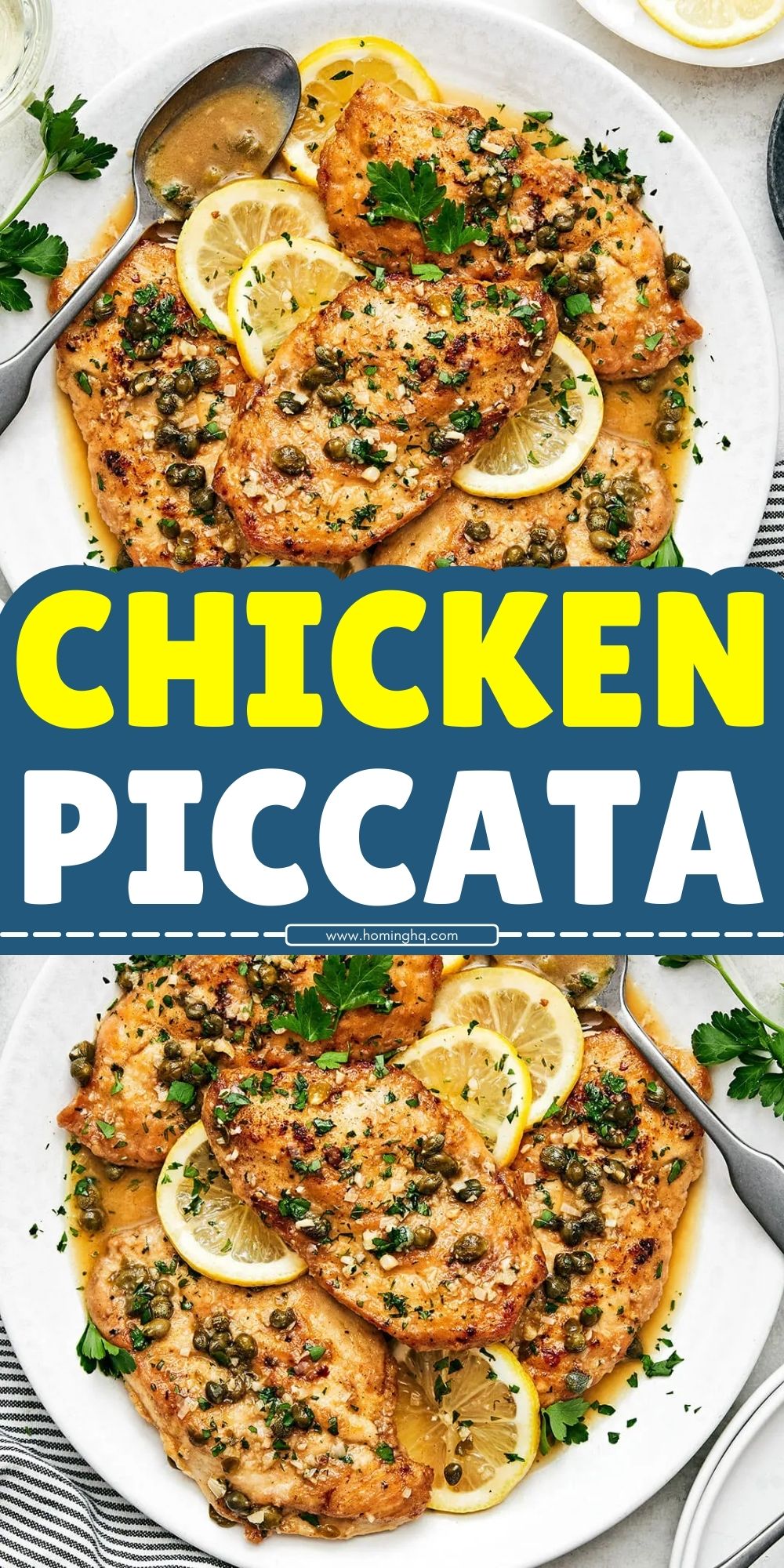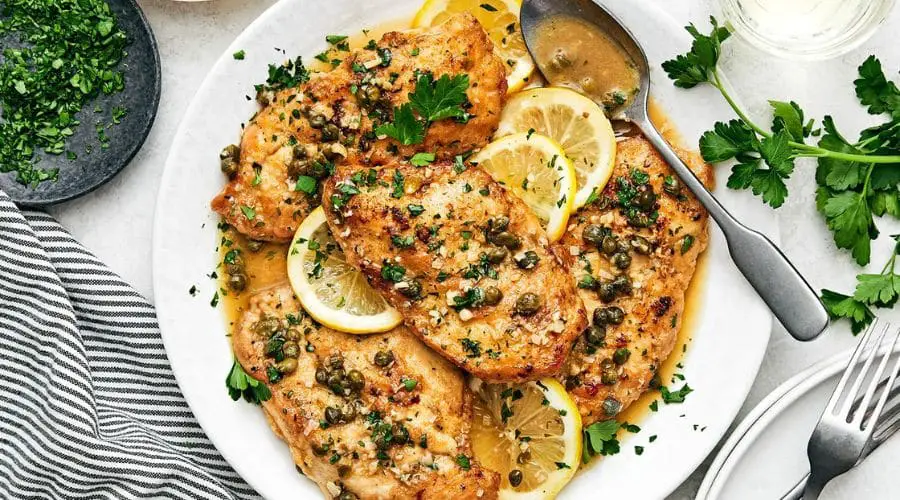All products are selected by our editorial team for quality. If you buy through our links, we may earn a small commission at no extra cost to you.
Chicken Piccata is a vibrant and flavorful dish that brings the tastes of Italy right to your table.
This classic recipe features tender chicken breasts in a tangy, buttery sauce made with fresh lemon, briny capers, and a splash of white wine.
Its light yet rich flavor profile makes it a perfect dish for both weeknight dinners and special occasions.
With just a handful of ingredients and a few simple steps, Chicken Piccata is easy to prepare but looks and tastes impressive.

What is Chicken Piccata?
Chicken Piccata is a traditional Italian dish made by pan-frying thinly pounded chicken breasts and serving them in a lemony, buttery sauce with capers.
The term “piccata” refers to the method of cooking, where meat is lightly seasoned, dredged in flour, and sautéed before being finished in a flavorful sauce.
This dish is known for its bright and tangy flavors, which come from the combination of lemon and capers, balanced by the richness of butter.
Although Chicken Piccata is often associated with Italian cuisine, it has become a favorite in many other culinary traditions due to its simple yet sophisticated flavor profile.
Ingredients for Chicken Piccata
To make Chicken Piccata, you will need the following ingredients:
- 4 boneless, skinless chicken breasts
- Salt and freshly ground black pepper, for seasoning
- 1 cup all-purpose flour, for dredging
- 2 tablespoons olive oil, for frying
- 2 tablespoons butter, for the sauce
- 1/4 cup fresh lemon juice (about 2 lemons)
- 1/4 cup capers, drained
- 1/2 cup dry white wine
- 1/2 cup chicken broth
- Fresh parsley, chopped, for garnish
For the best results, choose high-quality chicken breasts that are fresh and tender.
Fresh lemons will give the sauce a zesty flavor, while capers bring a salty, briny punch that enhances the dish.
Dry white wine is essential for deglazing the pan and adding depth to the sauce, but if you prefer not to use alcohol, chicken broth can be used as a substitute.
Step-by-Step Instructions

Step 1: Preparing the Chicken
Start by placing the chicken breasts between two sheets of plastic wrap or parchment paper.
Use a meat mallet or rolling pin to gently pound the chicken to an even thickness of about 1/2 inch.
Season both sides of the chicken breasts with salt and pepper to enhance their flavor.
Step 2: Dredging the Chicken
Pour the flour into a shallow dish.
Coat each chicken breast evenly with flour, making sure it is fully covered.
Lightly shake off any excess flour to ensure a crisp coating without being too heavy.
Step 3: Cooking the Chicken
Heat the olive oil in a large skillet over medium-high heat.
Once the oil is hot, add the chicken breasts and cook for 3-4 minutes on each side.
The chicken should turn golden brown and be fully cooked through.
Use a meat thermometer to check that the internal temperature of the chicken has reached 165°F (75°C).
Remove the chicken from the skillet and set it aside on a plate.
Step 4: Preparing the Piccata Sauce
In the same skillet, reduce the heat to medium.
Add the butter and allow it to melt.
Once melted, pour in the fresh lemon juice and white wine, scraping the bottom of the pan to release any brown bits.
Add the chicken broth and capers to the skillet, stirring to combine.
Let the sauce simmer for 2-3 minutes, allowing it to slightly thicken and become rich in flavor.
Step 5: Bringing It All Together
Return the cooked chicken breasts to the skillet, making sure they are submerged in the sauce.
Let the chicken simmer in the sauce for another 2 minutes.
This allows the chicken to absorb some of the sauce and infuse with the bright, tangy flavors.
Garnish with freshly chopped parsley for a pop of color and a hint of freshness before serving.
Tips and Tricks for the Perfect Chicken Piccata
To make sure your Chicken Piccata turns out perfectly every time, here are a few helpful tips:
- Don’t Overcook the Chicken
Chicken breasts can easily become dry if overcooked.
Be sure to cook the chicken just until it reaches 165°F (75°C) internally.
Using a meat thermometer is the most reliable way to ensure it’s perfectly cooked. - Achieve a Crispy Coating
Make sure to dredge the chicken in flour evenly and shake off any excess.
This will create a light and crispy crust when pan-fried, giving the dish its signature texture. - Balance the Sauce Flavors
The key to a good Piccata sauce is the balance between the tang of lemon and the saltiness of capers.
Taste the sauce as you go and adjust with more lemon juice, capers, or a pinch of salt if needed. - Use Fresh Ingredients
Fresh lemons give the sauce a bright and zesty flavor that bottled lemon juice can’t replicate.
Opt for high-quality capers and chicken for the best results. - Keep the Sauce Light
Chicken Piccata should have a sauce that’s light and flavorful, not thick or greasy.
If the sauce is too thick, add a little more chicken broth or wine to loosen it up.
How to Serve Chicken Piccata
Chicken Piccata is versatile and can be paired with various sides to create a balanced meal.
- With Pasta
Serve the chicken and sauce over a bed of pasta, such as spaghetti, angel hair, or fettuccine.
The pasta will soak up the flavorful sauce, making every bite irresistible. - With Mashed Potatoes
Creamy mashed potatoes are a comforting side that complements the tangy sauce beautifully.
Their rich, smooth texture contrasts perfectly with the crispy chicken and zesty sauce. - With Steamed or Roasted Vegetables
For a lighter option, serve Chicken Piccata with steamed green beans, asparagus, or roasted broccoli.
These vegetables add color, crunch, and freshness to the meal. - On a Plate or in a Bowl
Serve the chicken with its sauce in a shallow bowl or on a dinner plate, garnished with freshly chopped parsley.
This will enhance the dish’s presentation and highlight the vibrant, lemony sauce. - Wine Pairing
Chicken Piccata pairs wonderfully with a crisp white wine, such as Sauvignon Blanc or Pinot Grigio.
The wine’s acidity complements the tang of the lemon and balances the richness of the butter in the sauce.
Common Mistakes to Avoid
- Overcooking the Chicken
Chicken breasts can easily dry out if overcooked.
Make sure to monitor the cooking time closely and use a meat thermometer to avoid overcooking. - Skipping the Flattening Step
Flattening the chicken to an even thickness ensures it cooks uniformly and prevents one part from becoming dry.
Skipping this step could result in uneven cooking, with some parts of the chicken overcooked and others undercooked. - Using Too Much Flour
Coating the chicken with too much flour can lead to a heavy crust and an overly thick sauce.
Ensure you dredge the chicken lightly and shake off the excess flour to maintain a delicate texture. - Not Tasting the Sauce
The Piccata sauce should be well-balanced in flavor.
Don’t forget to taste it before serving and adjust the seasonings as needed, whether it’s adding more lemon juice, capers, or salt. - Making the Sauce Too Thick or Thin
The sauce should be light and slightly thickened, not overly runny or too thick.
If it’s too thin, let it simmer a little longer.
If it’s too thick, add a little more chicken broth or wine to loosen it up.
Conclusion
Chicken Piccata is a delightful dish that blends the perfect balance of tangy, savory, and buttery flavors.
With its crispy chicken, zesty lemon sauce, and briny capers, it’s a dish that never fails to impress.
By following the steps, avoiding common mistakes, and experimenting with different sides, you can easily make this Italian classic in your own kitchen.
It’s an ideal meal for both casual family dinners and special occasions, and its simple ingredients make it accessible yet sophisticated.
Enjoy the process, and don’t forget to share your results with friends and family!
Frequently Asked Questions
- Can I make Chicken Piccata ahead of time?
Yes, you can make the chicken and sauce in advance.
Store them separately in the refrigerator and reheat when ready to serve.
However, for the best results, it’s recommended to serve the dish fresh.- Can I use chicken thighs instead of chicken breasts?
Yes, chicken thighs can be used for a richer flavor.
Make sure to cook the thighs thoroughly, as they tend to take a little longer than chicken breasts. - What if I don’t have white wine?
If you don’t have white wine, you can substitute it with chicken broth.
A splash of vinegar or lemon juice can also add acidity if you prefer to retain the tangy flavor. - Can I make this recipe gluten-free?
Yes, you can make Chicken Piccata gluten-free by using a gluten-free flour blend for dredging the chicken.
Just make sure to check your chicken broth and wine for gluten content. - What sides go best with Chicken Piccata?
Chicken Piccata pairs well with pasta, mashed potatoes, or steamed vegetables.
For a lighter option, serve it with roasted or steamed green beans, asparagus, or broccoli.

Chicken Piccata
Equipment
- 1 Large Skillet (10–12 inches)
- 1 Meat mallet or rolling pin
- 1 Shallow dish for dredging flour
- 1 measuring cup (for liquids)
- 1 Meat thermometer (optional but recommended)
Ingredients
- 4 boneless skinless chicken breasts (about 1 ½ pounds)
- 1 teaspoon salt for seasoning
- ½ teaspoon freshly ground black pepper for seasoning
- 1 cup all-purpose flour for dredging
- 2 tablespoons olive oil for frying
- 2 tablespoons butter for the sauce
- ¼ cup fresh lemon juice about 2 lemons
- ¼ cup capers drained
- ½ cup dry white wine
- ½ cup chicken broth
- 2 tablespoons fresh parsley chopped, for garnish
Instructions
- Prepare the chicken: Place the chicken breasts between two sheets of plastic wrap or parchment paper.
- Use a meat mallet or rolling pin to pound the chicken to an even thickness of about ½ inch.
- Season both sides of the chicken with salt and pepper.
- Dredge the chicken: In a shallow dish, pour in the flour.
- Coat each chicken breast evenly with flour, shaking off the excess.
- Cook the chicken: Heat olive oil in a large skillet over medium-high heat.
- Once hot, add the chicken breasts and cook for 3-4 minutes on each side until golden brown and cooked through.
- Remove the chicken from the skillet and set aside.
- Make the sauce: In the same skillet, reduce the heat to medium and add butter.
- Once melted, pour in the lemon juice and white wine, scraping the bottom of the pan to release brown bits.
- Add the chicken broth and capers, stirring to combine.
- Let the sauce simmer for 2-3 minutes until slightly thickened.
- Combine the chicken and sauce: Return the chicken to the skillet, ensuring it's coated with the sauce.
- Simmer for another 2 minutes, allowing the chicken to absorb some of the sauce.
- Serve: Garnish with chopped parsley and serve immediately.
Notes
- If you prefer a lighter dish, you can substitute the butter with olive oil in the sauce.
- If you don’t have white wine, chicken broth or a splash of white vinegar can be used as a substitute.
- For a gluten-free version, use a gluten-free flour blend for dredging the chicken.
- Be sure to use fresh, high-quality lemons for the best flavor in the sauce.
- The capers add a unique salty flavor to the dish; make sure they are drained well before adding them to the sauce.

